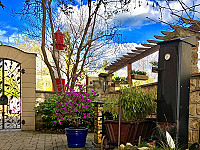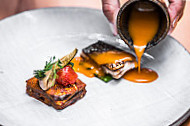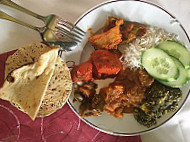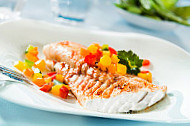
Teléfono: +493514718855
Dirección: Budapester Str. 32, 01069 Dresden, Germany, Germany
Ciudad: Dresden
Menú Platos: 30
Reseñas: 11414
Sitio Web: https://feldschloesschen-stammhaus.de/
"General: Again in Dresden. This time professional and solo, and actually I wanted to give a afterburner to my small summer cycle GDR-Völkerfreundschaften kulinarisch in today's time. I chose a Hungarian restaurant, Budapest. Located in an inhospitable neighborhood near the S-Bahn station Plauen. When I found it after a long walk, I had to read a unfortunately closed. In the Tripadvisor I read about the same fate of the restaurant Kulacs. The next time, maybe the Kakas when it's still alive. As a precaution, I had set up a plan B, that is, the near-facing log house. It is embedded in architectural residential and commercial shoe boxes on the four-lane Budapest street. As I was able to read in the map, the parent house is housed in the former machine house of the historic brewery site, which surpassed the bomb attack at the end of WK II. In a brewery room you can expect a generous and rustic atmosphere. This is where the tribal house is fully justified, so that it can be fully recommended to friends from brewhouses. The kitchen services in the large drinking facilities at best bring defensive and tasty brewhouse classics to the plate, which differ a little from region to region and have a culinary cut with the porkshaxe/icebone/skin. I couldn't quite convince myself of the maps I tried in the parent company if I think of the Schumacher or the füchschen in Düsseldorf or the Hofbräukeller in Munich. The audience on Tuesday night was clear and more local. Around 8 p.m., a large group of Japanese appeared, who took place at preordered tables and was commanded by a strict bear guide. They hardly sat, water carafes and glasses were taken. Some dared to order beer and the supposers were already applied. This looked like a quick feed, but it might have been wanted. The price-performance ratio in the trunk house is somewhat cheaper than in the Wenceslas and therefore I give 3.5 stars. On the homepage only the menu and photoimpressions of the building and the premises can be found: [here link]. Service: In brewhouses, you can expect a waiter type, which quickly brings the beer to the table and b has not fallen to the mouth. Its culmination is the Rheinische Köbes, who reliably puts old or carol on the lid without question, likes to leave a spell and cares for the image. The male waiters had enough of this esprit in the stem house. On the black polo shirt with logo and the bright red field-slip apron visually well recognizable, in particular a larger female circus was openly supervised. My feminine operator was a little more friendly. Card, beers and digestive liquors came flott to almost just in time and the dishes at pleasant intervals. So solid and playful and worth 3.5 stars. In the main house there are from the production of the brewery of the Val di Pilsener, Rock Cellar, Zwick and Schwarzer Steiger. 0.3 l for strong 2,90 €, the half for more moderate 3,90 € and the size is pleasantly discounted for the big sausage to 6,90 or 7,10 €. I drank the twig and the rock cellar Pils and the tumble beer is preferred to my taste. Possibly that the beer is tapped very cold. A few wines I found on the map, starting at 3,90 € for 0.2 l and a bottle of water with 0.75 l comes on proud 5,40 € there is the measure cheaper! The basic skeleton according to Brauhausart form two soups potato soup, Soljanka and the main house classic Sülze, pork roasts, haxe, sour roasts, schnitzel. A cup of potato soup, according to map with marjoram and bacon, should be refined to form the fruitful opening €4.20 . I was delighted about the dimensions of the cup, so it had then. The soup was only warmed and without visible inlay. The supremeness and a basic taste of potatoes as a basis could have made something of soup with decent spice. But neither bacon nor marjoram were to taste, a small sour stab reported the tongue. Gschmackiger then went on to €14.50 with the Braumeisterschnitzel . As supplements, a potato zucchini pan and a herbal dip were announced. Everything was found, including roast sauce on the plate. It is good that the successful herbal dip based on fresh cheese could be taken from the plate in an extra small bowl. On its basis, the oil mixed, in which the rosemary flakes and very soft zucchini slices were cooked and the frying sauce. Both are all right, but in the Melange both losers. Here, the potato zucchini pan, as the name suggests, should be applied in its own pan. I found the carving filled with peppers and cheese. The panade is chessful and well spiced and inside thin slices of a strongly padded coarse salami that recalled a good chorizo. The melted cheese could only play the tasteful junior part. The portion size once again confirmed that one cannot expect powerful portions in brewhouses. A fluffy soup, an oily-soaked bilge and a good carving yield 3.5 stars according to my algorithm. Ambience: I like to give 4.5 stars for the ambience. Half the way to the top is prevented because the tables intended for four tables are somewhat small. Otherwise, the tribal house offers almost everything a brewhouse makes. So a main area brewhouse with large walks under a copper roof such as a brewing pan, dark cassette paneling, bare tables, a warm, reddish tile floor, historical motifs as wall decorations and as eye-catcher a switchboard of machine house times, which however flashes albern. In addition, there is a gallery as an upper level in the brewhouse with lift access, a brewery museum in the tower and various other side gates, which provide the homepage information. It goes back to the terraced beer garden. This is almost all because a classic sponge with standing tables is missing for the pressure refueling. Cleanliness: In the restaurant everything is clean. The toilets are modern and can leave some collective urine in the men's refreshment."
Menú completo - 30 opciones
Todos los precios son estimaciones en menú.
Ensaladas
Salate
Postre
Hauptgerichte
Suppen
Escalope
Carne
Especialidades Mixtas
Pizza
Papas
Zusätzlich Ab 17.30
Unsere Fränkischen Klassiker
India
Regional Francón**
Para Niños
Postres
Cazuelas De Patatas
Vorspeisen Und Leichte Gerichte
Dirección

Reseñas
Dresden

Dresde, un centro cultural con arquitectura barroca junto al río Elba, ofrece platos abundantes como el Sauerbraten y la sopa de papa sajona, mostrando la rica tradición culinaria alemana.
Categorías
-
Deutsch Saborea los ricos sabores de la cocina tradicional alemana, con carnes abundantes, chucrut ácido y salsas suculentas. Disfruta de platos auténticos que llevan un sabor de Alemania a tu mesa.
-
Parkplätze
-
Warme Gerichte
-
Familienfreundlich
Comodidades
-
Kellner
-
Gruppen
- Carta
-
Mitnahme
- menú
-
Lieferung















